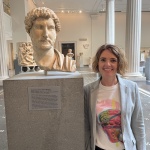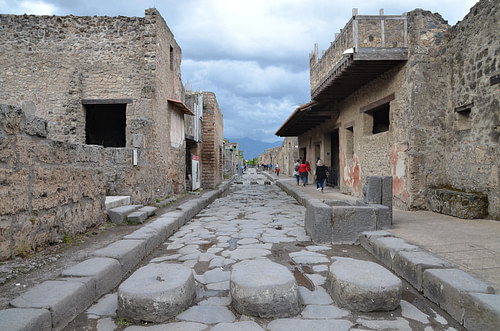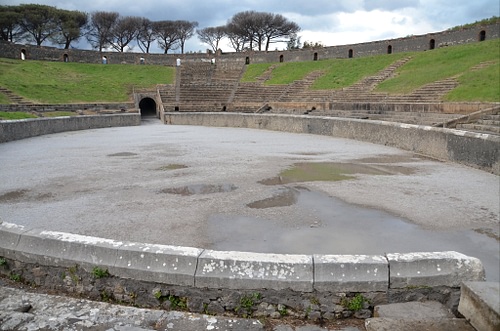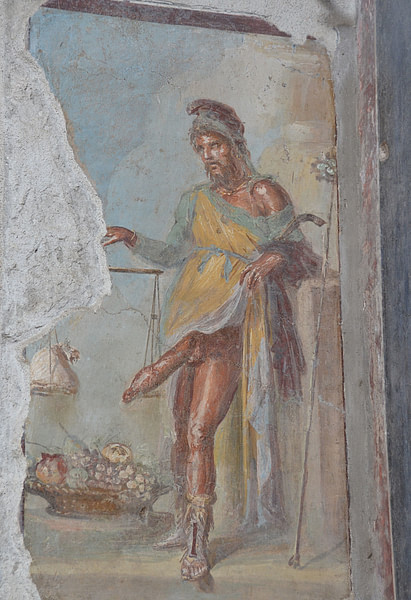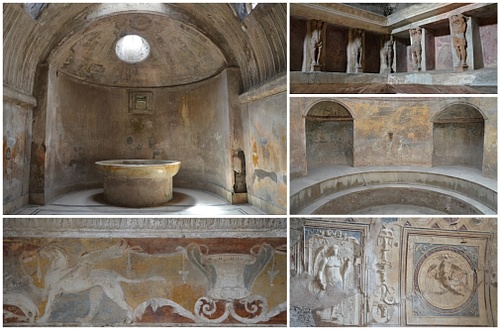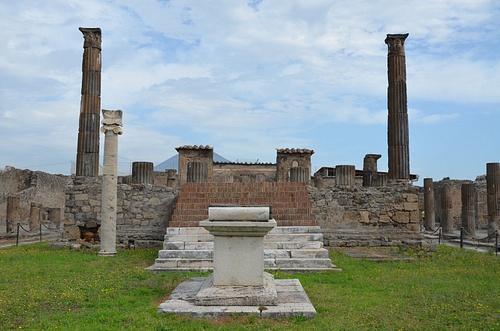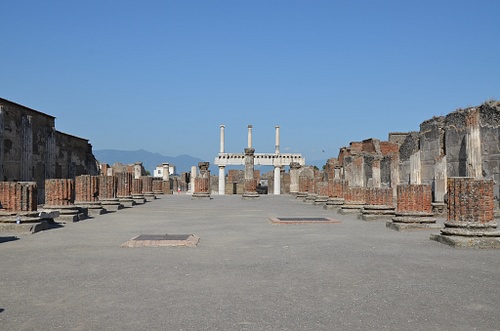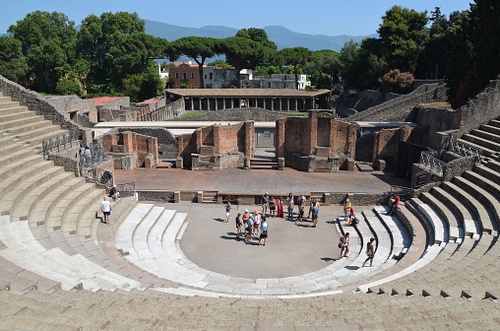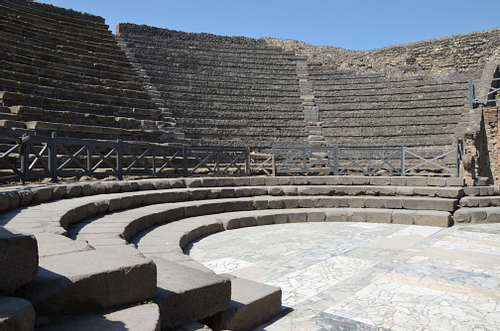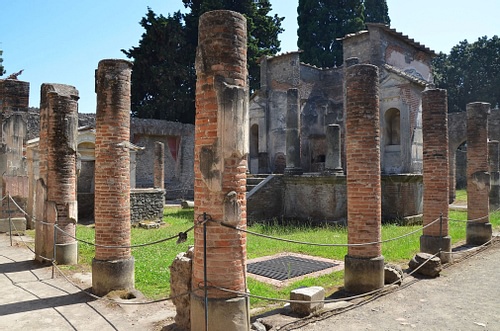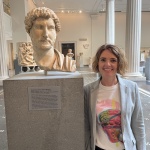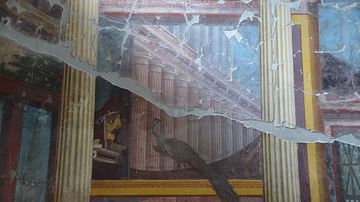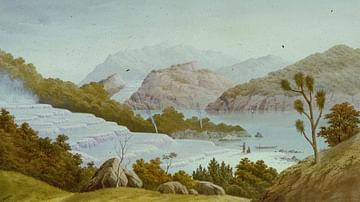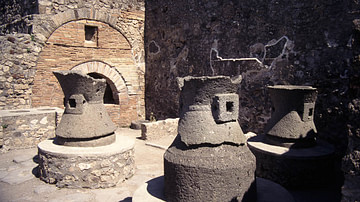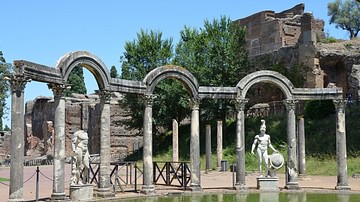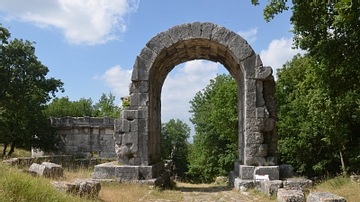Visitors to Naples and its surrounding area could be overwhelmed by the number of archaeological wonders to see. Buried for centuries beneath tons of volcanic ash and debris, the archaeological sites scattered along the coast of Naples are among the most spectacular and best-preserved remains of the ancient Roman-Italic world. No other place in the world gives a deeper insight into Roman everyday life than the dramatic seaside towns of Pompeii and Herculaneum. The eruption of Mount Vesuvius in 79 CE not only destroyed these ancient cities but, ironically, it preserved them for future discovery. Every year these perfectly preserved ruins attract millions of visitors who come to see a unique and fascinating snapshot into Roman life.
Ancient History Encyclopedia is launching an exciting new travel series devoted to the archaeological sites around the Bay of Naples. We kick off this new feature with Pompeii. The following guide is particularly intended for independent travellers who wish to make the most of their self-guided tour of Pompeii.
A Prosperous City
Thanks to its strategic position near the Sarno River, Pompeii was an important commercial centre, a trading hub noted for exporting goods such as olives, olive oil, wine and fish sauce (garum). Once home to approximately 12,000 people, the city boasted an assortment of baths, houses, temples, public buildings, markets, brothels, taverns and cafes, and a 20,000-seat arena. Probably originating from an amalgamation of five small towns, Pompeii's first city plan developed in the 6th century BCE when Italic people called the Oscans inhabited the area. Over the next centuries, the city fell to the Greeks and the Samnites before becoming a Roman colony in 80 BCE. Pompeii prospered until it was struck by a massive earthquake in 62 CE, damaging most of its buildings. The fatal blow came upon the city in 79 CE when Mount Vesuvius violently erupted.
The Eruption & Aftermath
In 79 CE, in only 24 hours, a powerful eruption completely smothered the cities on the foothills of Vesuvius. The volcano, which had been dormant for hundreds of years, erupted with tremendous force sending a tall mushroom cloud of rock and gas over 30 km (18.6 miles) into the sky. The cloud then collapsed and triggered a massive pyroclastic surge down the slopes of Vesuvius, killing everyone who had not yet fled. At Pompeii, most of the houses lay under a blanket of pumice and ash up to 5 metres (16 feet) deep. It would be some 1700 years before these Roman cities were rediscovered by archaeologists, and the extent of their preservation was extraordinary.
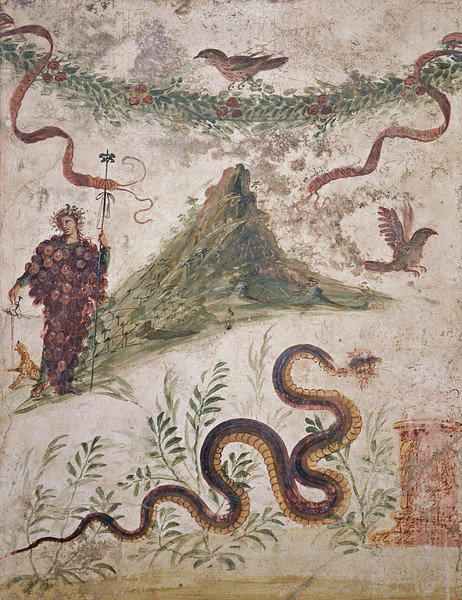
Rediscovering Pompeii
After its catastrophic demise, centuries of history were sealed away until 1594 CE, when an architect stumbled across the ruins while digging a canal. However, it wasn't until the appointment of archaeologist Guiseppe Fiorelli in 1861 CE that systematic excavations were undertaken. Fiorelli was responsible for making the famous plaster casts of the victims of the eruption which you can now see around the site. Of Pompeii's original 66 hectares, 44 have now been excavated, and excavations are continuing to this day.
Uncovering New Treasures & Rewriting History
270 years after the discovery of Pompeii, large scale archaeological excavations have resumed in Pompeii in Regio V, an area of over 1,000m² (10,000 ft²) that was still buried under volcanic debris. More than 200 experts and technicians are at work on the Great Pompeii Project, the €105 million ($116 million) conservation, maintenance and restoration program launched in 2012 CE and largely funded by the European Union. New structures (including a brightly coloured snack bar), colourful frescoes, mosaics of mythological figures, as well as graffiti were among the discoveries which emerged from the archaeological dig.
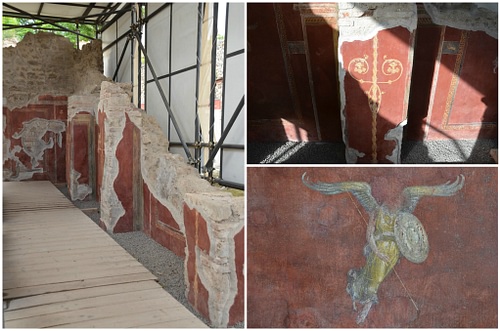
Another recent discovery was the scrawled piece of text on a wall of a house suggesting that the eruption occurred in October of 79 CE, two months later than previously thought. According to Massimo Osanna, the head of the Pompeii site, the correct date of the eruption may, in fact, be 24 October. After almost two millennia, the ruins of Pompeii continue to astound us with its rich archaeological legacy. The new excavation areas are yet to open to the public.
Practical Information
Pompeii is an easy trip from Naples or Sorrento. The local train service around Vesuvius is the Circumvesuviana Line that runs between Naples and Sorrento and has stops near all the major archaeological parks. Trains depart about every 30 minutes from the Naples central train station, and the journey to Pompeii takes about 30 minutes. The ticket fee is currently just under €3 one-way.
A single ticket to get into the Pompeii excavations at the time of writing costs €15. Also available is a three-day pass to access three sites for €18: Pompeii, Oplontis and Boscoreale. The tickets can be purchased from the official ticket offices at the site entrances. The Archaeological Park of Pompeii also proposes advance tickets from the online ticketing service TicketOne which allow visitors to skip the queues by using a fast lane ticket window. All your tickets include a map and a small pocket guide to the sites. You can also download your PDF guides in advance of your trip (see here).
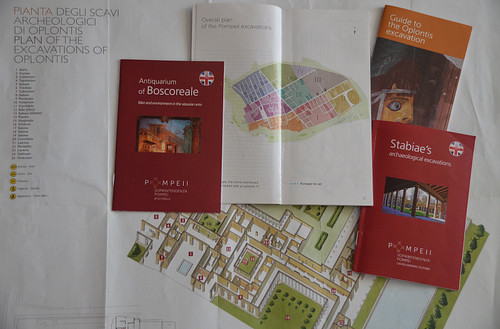
There is also the Campania Arte Card (official site) which allows entrance to Pompeii, Herculaneum, Oplontis, Boscoreale, the Archaeological Museum of Naples and over 70 other cultural and archaeological sites throughout the Campania region, as well as unlimited travel by public transportations. The 3-day Campania Arte Card costs €32 and gives free admission to the first two sites of your choice and then up to 50% discount from the 3rd site onwards. The 7-day Campania Arte Card costs €34 and gives free admission to the first 5 sites visited and then up to 50% discount on further sites. However, it does not include public transport. The Campania Arte Card is available from most major museums and participating archaeological sites. It can also be bought online in advance from the Campania Arte Card official website.
Visiting Pompeii
The excavations of Pompeii are justifiably among the most popular sights and day-trip destinations in Italy. Since the first planned excavations in the mid-18th century CE, Pompeii has astonished scholars and tourists alike. Its ghostly ruins make for one of the world's most gripping and exhilarating archaeological experiences. But Pompeii is also one of the busiest archaeological sites in the world with some 4 million visitors every year. You will not be alone, and in high season the streets of Pompeii can be totally packed. With its 49 hectares (121 acres) of excavated area, Pompeii is vast, and visitors can easily get lost in the maze of streets, even with a map, and there are no guards to point you in the right direction.
It is important to know that there are two main entrances to Pompeii. Porta Marina is the main entrance, and it's where you can get an audioguide. It's also closest to the Circumvesuviana train line. However, this makes it much busier, and the queues for tickets can be longer during busy periods. The other entrance is at Piazza Anfiteatro and is much quieter so you will get in faster. Piazza Anfiteatro is close to the central Pompeii train station which can be reached with Trenitalia trains (albeit only 9 trains running every day).
Guided tours can be booked at the information desk at the Porta Marina entrance. The service is carried out by qualified guides certified by the Region of Campania, who can be identified through special badges. Guided tours can be useful for visitors who have a limited amount of time and want to see the highlights without wasting time reading maps and finding the sights. If you choose to do it alone, remember that Pompeii is an entire buried city and that it is unlikely you will be able to see everything in just one visit. You should, therefore, determine how much time you want to spend at Pompeii and plan your visit accordingly. Also, remember that you will be walking on old Roman roads so do wear something comfortable. And don't forget to bring a little snack and water. A small bottle is fine, there are lots of fountains where you can refill.
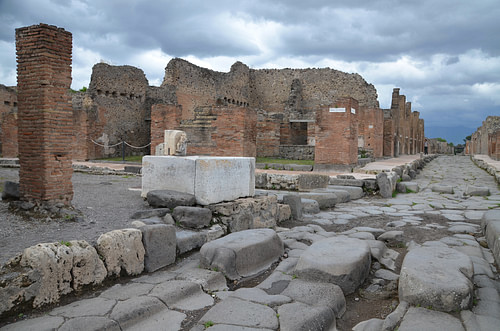
After buying your entrance ticket for Pompeii, remember to pick a map at the info point as well as the free 148-page booklet. Unfortunately, due to a lack of staff, a lot of the best private houses are locked, and you will find a number of places you were supposed to get into closed. Whatever your planned itinerary, be prepared for any changes. The top sights are usually open all day, but some houses have reduced opening hours or are closed for maintenance. The Pompeii official website has information about openings and closures if you click on each REGIO here.
There are different types of itineraries depending on your time availability. The free map of Pompeii provided at the info point offers four different itineraries lasting 2 hours, 3 hours, 5 hours and 7 hours. Here we suggest a 5-hour itinerary and 20 sights that you should include during your visit. The suggested route begins at Piazza Anfiteatro, keeping the area of the Forum and the Basilica for the end as the crowds tend to congregate there. By the time you finish your visit, all big groups will have left the site, usually by mid-afternoon. You will go past lots of things on this route, but really, if you spot an open door, just go through it. Many houses are freshly restored and have recently reopened.
Our Recommended Itinerary with 20 Must-See Sights
1. Large Palaestra (open all day)
The Large Palaestra was built as a space to practise gymnastics and athletics. Its huge portico-flanked courtyard includes the remains of a large swimming pool. Reopened to the public in 2015 CE, the Palaestra is now used as a permanent exhibition.
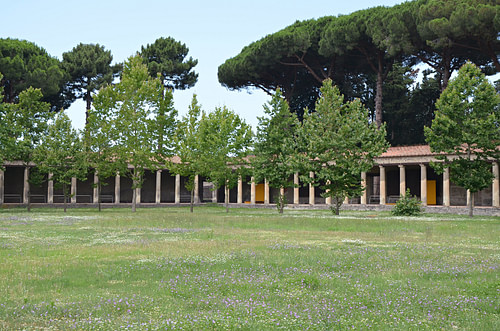
2. Amphitheatre (open all day)
The Amphitheatre was used for gladiatorial combat and is the oldest one of its kind in existence. Built 150 years before the Colosseum in 70 BCE, it could hold up to 20,000 spectators.
3. Praedia of Julia Felix (open all day)
Located along the Via dell'Abbondanza, the Praedia of Julia Felix is one of the largest houses in Pompeii. Its owner, Julia Felix, converted portions of it to apartments available for rent and other parts for public use. The complex consisted of an atrium house, large gardens, a thermal facility with hot baths and a large park. It underwent a wonderful facelift and is now open to the public.
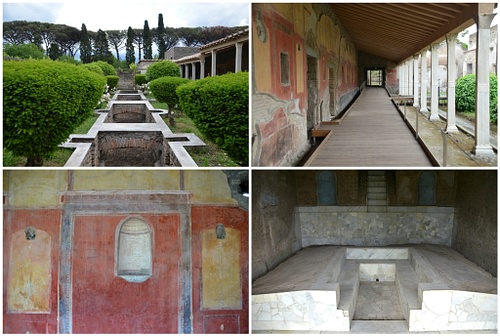
4. Thermopolium of Vetutius Placidus (visible from street)
The thermopolium (cook-shop) of Vetutius Placidus opens directly onto the south side of the via dell'Abbondanza. Thermopolia were bars which served hot and cold food and drinks. The 'L' shaped masonry counter has large storage jars which were used to hold food. On the rear wall of the bar is a painted lararium with a scene depicting the Genius of the household performing a sacrifice over a small folding altar.
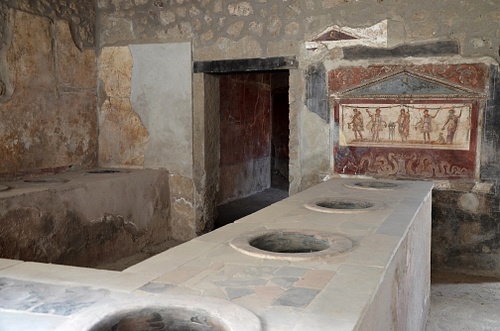
5. Dog Mosaic in the House of Paquius Proculus (visible from street)
The House of Paquius Proculus is closed to the public, but its most striking feature is visible from the outside. It is a fine mosaic paving which depicts a guard dog chained to a door.
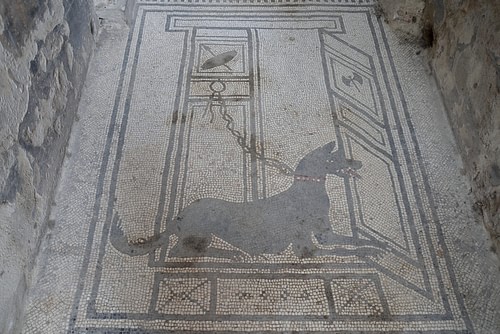
6. Fullonica of Stephanus (open all day)
The Fullery of Stephanus is one of the most complete laundries found in Pompeii where manufactured cloths were washed and stains removed. Stephanus' laundry was built just after the earthquake of 62 CE, transforming a private house into a modern factory. The building has recently undergone extensive restorations.
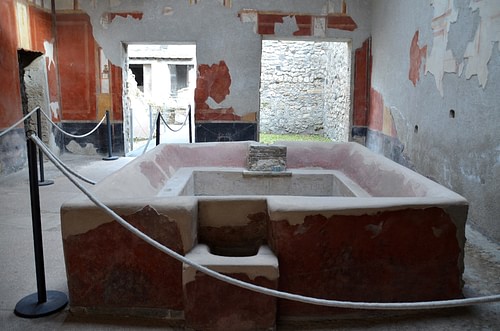
7. Stabian Baths (open all day)
The Stabian Baths are the oldest baths in Pompeii. The complex covers a total surface area of over 3,500 sq m and is divided into two adjacent sections respectively reserved for men and women and includes an open area (palaestra) which was used for exercise. The men's baths were elaborately decorated with polychrome stuccoes.
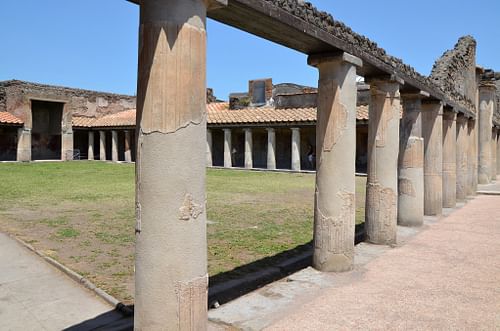
8. The Lupanar (open all day)
The brothel (lupanar in Latin) is one of the most-visited buildings in Pompeii, and you will most probably have to queue to get in. The Lupanar has two floors and 10 rooms fitted with built-in beds as well as a small latrine. Above the doors leading into the rooms are paintings showing erotic scenes.
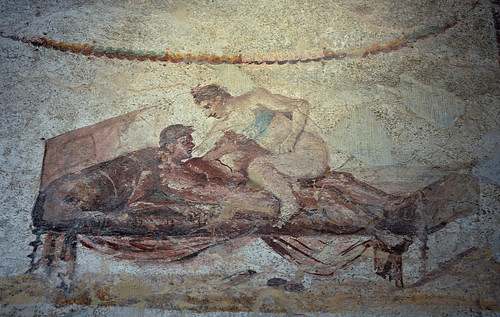
9. House of Marcus Lucretius (open all day)
The most interesting element of the House of Marcus Lucretius is the garden overlooking the atrium area. It features an elegant marble waterfall fountain supplied by a jet of water that gushed from a statue of Silenus.
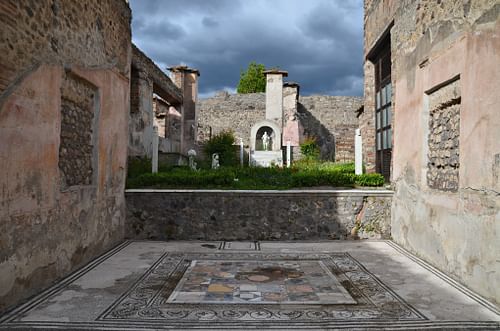
10. Bakery of Popidius Priscus (visible from street)
Bread in Pompeii was produced daily in local bakeries. About 35 bakeries have been found, each supplying their local area. The Bakery of Popidius Priscus contains four large millstones, traces of a stable, four storage rooms, and a large oven which was used for baking the bread.
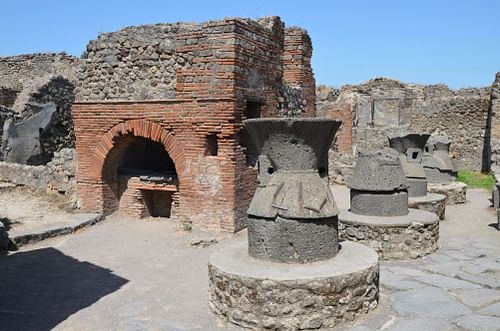
11. House of the Prince of Naples (open all day)
The House of the Prince of Naples has a beautiful atrium with an impluvium (pond) and a marble table with richly carved supports. The walls of all the rooms are decorated in the Fourth Pompeian Style with life-size images of Bacchus and Venus painted on the walls of the summer triclinium. The garden of the house has a temple style lararium that was used for family worship.
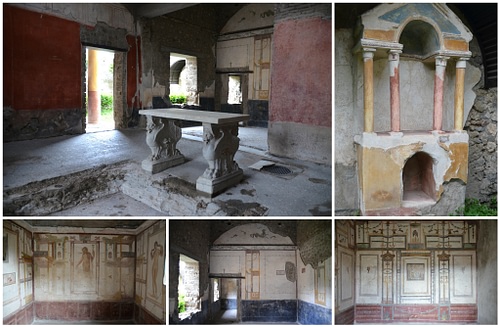
12. Priapus Fresco in the House of the Vettii (visible from street)
The house is usually not open to the public but its most striking feature, a fresco of the god of fertility Priapus, can be seen from the street if you look through the doorway entrance. Priapus is shown weighing his very large phallus against a bag containing money. The fresco probably symbolised the economic prosperity of the owners, the Vettii brothers, who became wealthy through trade.
13. House of the Faun (open all day)
The House of the Faun is one of the most visited houses in Pompeii. Its name comes from the bronze statue of the Dancing Faun found in the middle of the impluvium in the main atrium. The house occupies an entire city block or insula. It is organised around two atriums and two peristyles with a series of rooms, including bedrooms (cubicula), dining rooms (triclinia), reception rooms, an office (tablinum) as well as rooms for domestic service. In front of the main entrance is the word HAVE, meaning welcome.
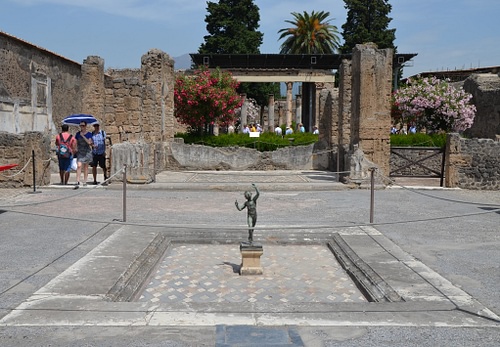
14. Villa of the Mysteries (open all day)
Located outside the city walls of Pompeii, the Villa of the Mysteries is regarded as one of the best-preserved country villas in the area of Vesuvius. The villa owes its fame to the very fine wall paintings that cover the walls of one of its reception rooms. A mysterious scene with life-size figures in the Second Pompeian Style seems to depict the initiation rite of a young girl into the Dionysian mysteries. The other rooms also preserve beautiful examples of Second Style wall decoration with imitation marble decoration.
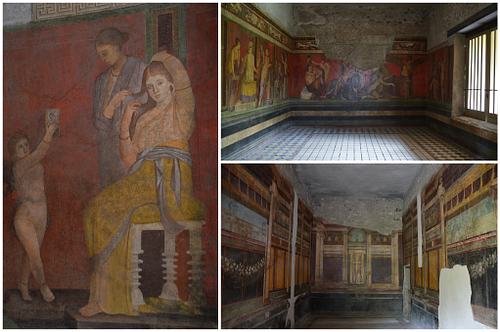
15. Forum Baths (open all day)
The Forum Baths were also subdivided into men's and women's sections, each with their own independent entrance. The walls are beautifully decorated with frescoes of garden scenes, and the vault ceilings are embellished with stucco friezes.
16. Sanctuary of Apollo (open all day)
The Sanctuary of Apollo is one of the oldest places of worship in Pompeii. The temple stands on a high podium and is surrounded by a continuous colonnade which was originally two-storeys high. At the foot of the stairs is a large altar with the dedicatory inscription with the names of the four officials who erected the temple around 80 BCE.
17. Forum & Basilica (open all day)
The Forum was the centre of public life, and the oldest part of Pompeii. It was also the site of gladiatorial games before the amphitheatre was constructed. Surrounding the Forum are a number of important administrative and religious buildings, including the Temple of Jupiter.
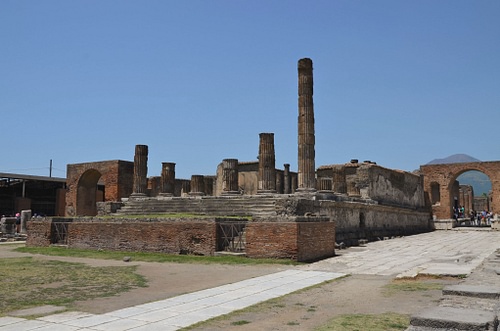
The Basilica stands near the west corner of the Forum and is the oldest and most important public building in Pompeii. It is also one of the oldest examples of this type of building in the entire Roman world.
18. Theatres & Gladiators Barracks (open all day)
The Large Theatre was a huge 5000-seat theatre built in the Greek type and carved into the natural slope of the hill. During the reign of Augustus (27 BCE - 14 CE), the theatre was significantly restored and enlarged according to the Roman style. Today, the Large Theatre hosts the annual Pompeii Theatrum Mundi, a summer festival of classical theatre.
The quadrangular portico located behind the stage of the Large Theatre was originally designed as a space for the audience to stroll in during the intervals of the theatre shows. After the earthquake of 62 CE, the building changed its function and was turned into barracks for the gladiators.
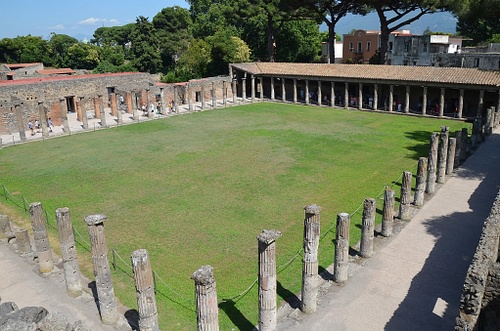
Next door is the Small Theatre, a small roofed theatre (odeon) used for musical and singing performances as well as for miming, the most popular theatrical genre at the time. The building had a seating capacity of about 1,500.
19. Temple of Isis (open all day)
The temple was dedicated to the Egyptian goddess Isis whose cult was widespread throughout the Roman Empire. It is situated in the centre of a porticoed courtyard and stands on a raised podium. The portico was decorated with fresco paintings, now in the National Archaeological Museum in Naples, containing images of Egyptian landscapes and Nilotic scenes. On the eastern side of the complex is a small building with a stairway leading down to an underground basin containing the sacred waters of the Nile.
20. House of Menander (reduced hours)
The wealth of decoration and the grandeur of its atrium and peristyle make this house one of Pompeii's most impressive homes. It owes its name to a painting of the Athenian playwright Menander placed in the portico. The walls were richly decorated with Fourth Style frescoes depicting scenes from the Iliad and the Odyssey as well as Nilotic and marine landscapes. The house also had a small thermal area.
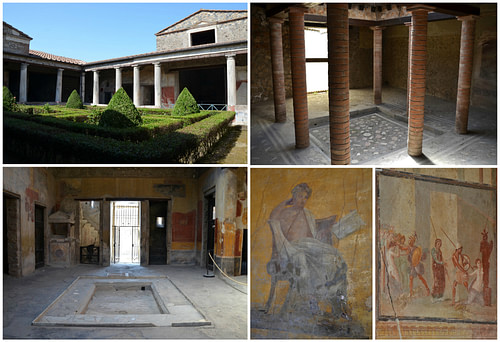
A trip to Pompeii would not be complete without a visit to the Archaeological Museum in Naples, home to the Farnese collection and the best artworks, mosaics and frescoes recovered from the excavations of Pompeii and Herculaneum. It also has an extensive collection of Egyptian ancient Greek artefacts. Plan to spend around two/three hours to see the highlights of the museum and about four hours to go into more detail of the vast collection on display.
